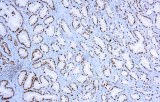
Anti-ERG CE/IVD for IHC - Soft Tissue pathology
ERG, the ETS related gene, belongs to the ETS family that plays important roles in cell development, differentiation, proliferation, apoptosis and tissue remodeling. This family of transcription factors contains approximately 30 members that share a highly conserved DNA-binding domain (ETS domain) and differs from each other in other domains (such as absence or presence of the Pointed/SAM domain) and are thus distinguished in sub-families. The aberrant expression of several ETS proteins is involved in tumor development and progression. ERG belongs to the Erg/Fli-1 sub-family. Its involvement in human cancers has been widely studied. ERG is linked to normal processes such as mesoderm formation and is found to form functional complexes with Jun/Fos, with the resulting ternary complexes regulating expression of proteins such as metalloprotease-1 (MMP-1) and MMP-3. EWS-ERG, or EWS-Fli-1 fusion, is a characteristic of Ewing's sarcoma. TMPRSS2-ERG fusion, which occurs on account of translocations and interstitial deletions, is implicated in aggressive forms of prostate cancer. Eighty percent of prostate tumors contain genomic fusions of TMPRSS2 and members of the ETS family of transcription factors. Of these, about 50% contain TMPRSS2-ERG fusions. Interestingly, prostate cancers with TMPRSS2-ERG fusion have been found to have five morphological features: blue-tinged mucin, cribriform growth pattern, macronucleoli, intraductal tumor spread, and signet-ring cell features. ERG overexpression is associated with aggressive tumor behavior and patient survival in prostate cancer. ERG antibodies label endothelial cells, lymphocytes and prostate cancer cells.


Prostate carcinoma
Prostate cancer
Search result : 3 product found
Refine your search :
RUOCE / IVD
- rabbit 3
- Primary antibody
- IHC 3
- IHC569 3
Cat#
Description
Cond.
Price Bef. VAT
‹
›


